BROWNING'S PLATYSCOPIC MAGNIFIER
MAKER: JOHN BROWNING
c. 1890 (4th Qtr 19th C.)
 Although before 1875 John Browning had sold simple lenses and Coddington Magnifiers, in 1875 he started to market and sell a unique group of aplanatic, achromatic triplet magnifiers in 'tortoise shell' casing which he called his 'Platyscopic Magnifier'. These were likely made to the design of the German inventor Steinheil who first made these in 1864. This example, is one of his lower power models. It measures about 1 3/4 inches (45.5 mm) in greatest dimension when closed, excluding the metal rings. Open it is 3 inches (76 mm) long. It is about 7/8 an inch (22.5 mm) high. The lens casing has a 18mm outside diameter. The outer casing is made of high quality 'tortoise (turtle) shell', the lenses mounted in Ebonite (hard rubber). The outer 'tortoise shell' casing is less than 1/16 inch (1.6 mm thick. It is signed in white letters on the lens casing: 'John Browning, 63 Strand,London'. This is a 15 power instrument, and has a field of view of about 10.5 mm.
Although before 1875 John Browning had sold simple lenses and Coddington Magnifiers, in 1875 he started to market and sell a unique group of aplanatic, achromatic triplet magnifiers in 'tortoise shell' casing which he called his 'Platyscopic Magnifier'. These were likely made to the design of the German inventor Steinheil who first made these in 1864. This example, is one of his lower power models. It measures about 1 3/4 inches (45.5 mm) in greatest dimension when closed, excluding the metal rings. Open it is 3 inches (76 mm) long. It is about 7/8 an inch (22.5 mm) high. The lens casing has a 18mm outside diameter. The outer casing is made of high quality 'tortoise (turtle) shell', the lenses mounted in Ebonite (hard rubber). The outer 'tortoise shell' casing is less than 1/16 inch (1.6 mm thick. It is signed in white letters on the lens casing: 'John Browning, 63 Strand,London'. This is a 15 power instrument, and has a field of view of about 10.5 mm.
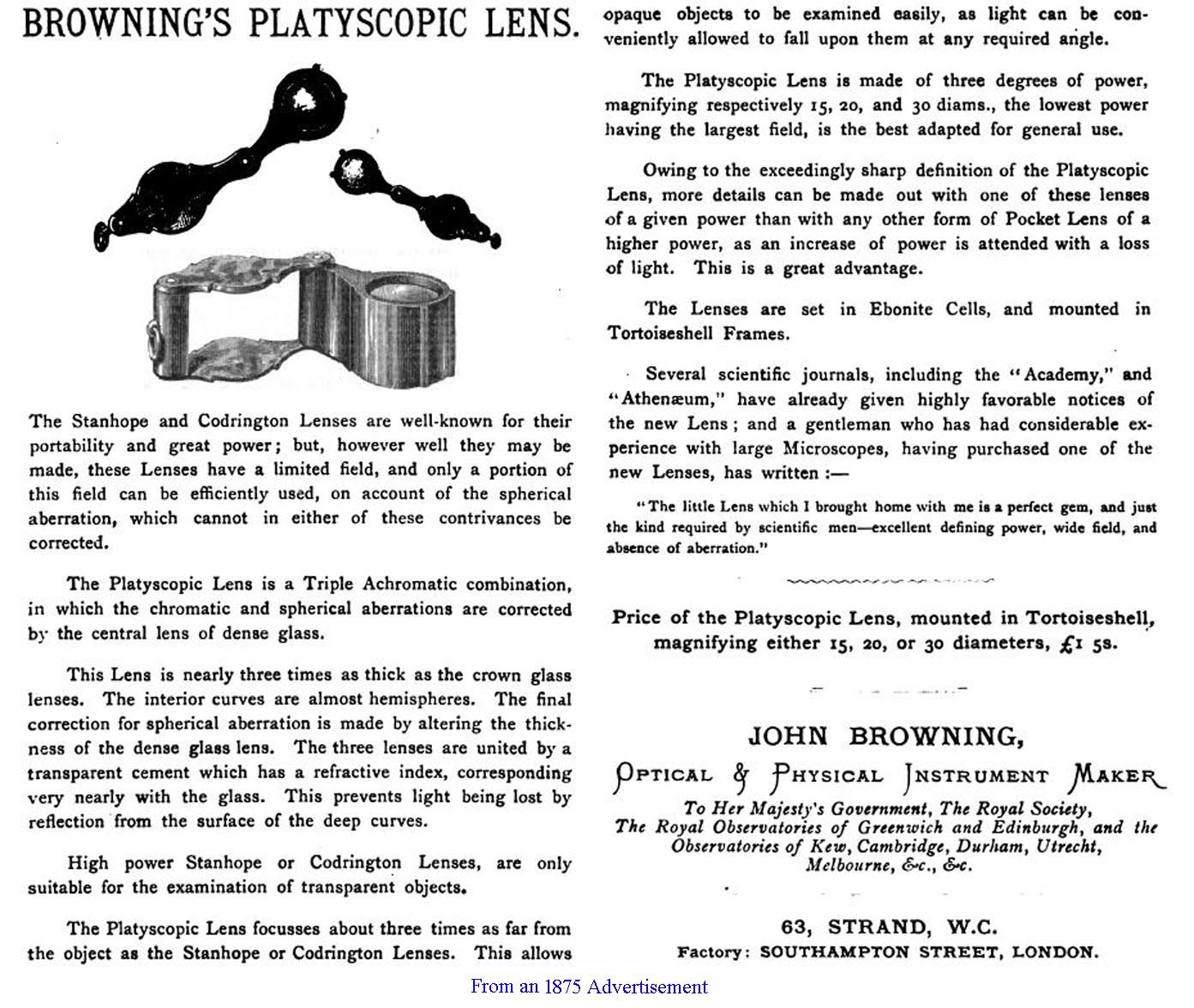
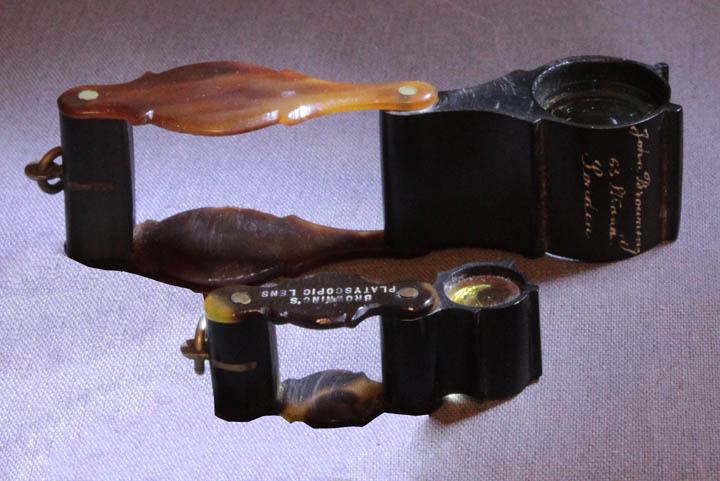 The 'platy' was initially offered in three powers. These were 15, 20, and 30. The outer casing was made of 'tortoiseshell' while the lens was housed in hard rubber, also known as 'Ebonite'. The Browning Platyscopic magnifier was advertised no later than 1875 and was first noticed in the Monthly Microscopical Journal of 1876. As can be seen from the images and the advertisements, the 15X version was about twice the size of the 30X version.
The 'platy' was initially offered in three powers. These were 15, 20, and 30. The outer casing was made of 'tortoiseshell' while the lens was housed in hard rubber, also known as 'Ebonite'. The Browning Platyscopic magnifier was advertised no later than 1875 and was first noticed in the Monthly Microscopical Journal of 1876. As can be seen from the images and the advertisements, the 15X version was about twice the size of the 30X version.
For a more detailed history of this magnifier, please the the page about the higher power (30X) version
The author is indebted to Dr Joe Zeligs for providing many of the ads and catalog entries of the Browning Platyscopic Magnifier found on this and other web pages.

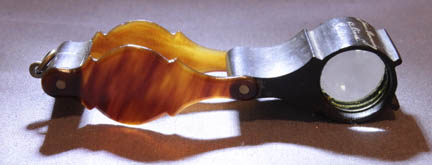
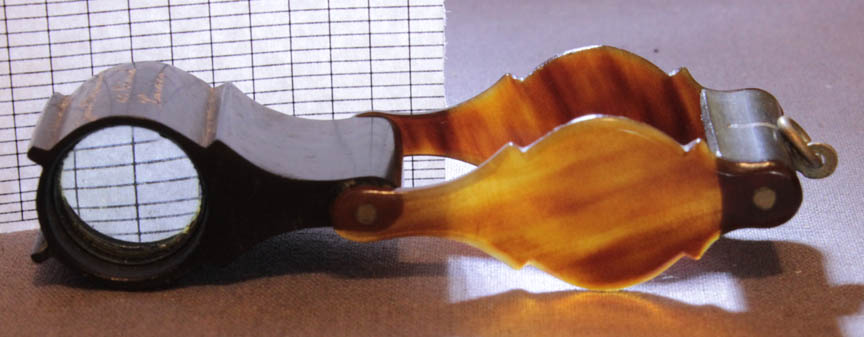
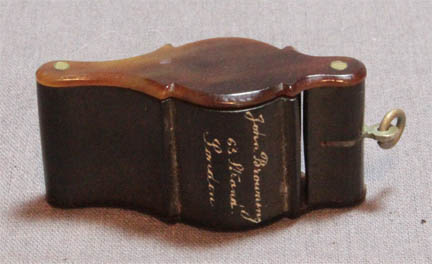
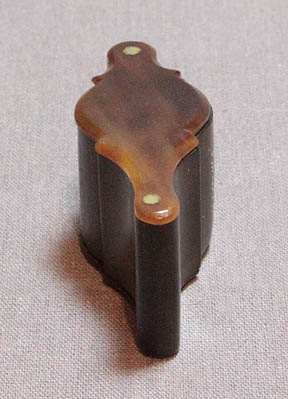
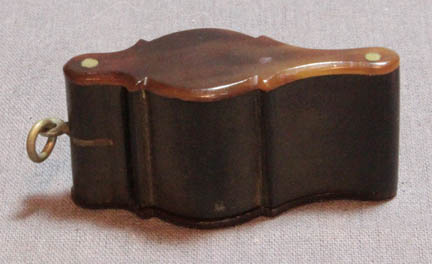
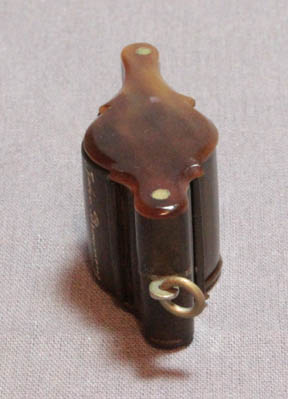
 Although before 1875 John Browning had sold simple lenses and Coddington Magnifiers, in 1875 he started to market and sell a unique group of aplanatic, achromatic triplet magnifiers in 'tortoise shell' casing which he called his 'Platyscopic Magnifier'. These were likely made to the design of the German inventor Steinheil who first made these in 1864. This example, is one of his lower power models. It measures about 1 3/4 inches (45.5 mm) in greatest dimension when closed, excluding the metal rings. Open it is 3 inches (76 mm) long. It is about 7/8 an inch (22.5 mm) high. The lens casing has a 18mm outside diameter. The outer casing is made of high quality 'tortoise (turtle) shell', the lenses mounted in Ebonite (hard rubber). The outer 'tortoise shell' casing is less than 1/16 inch (1.6 mm thick. It is signed in white letters on the lens casing: 'John Browning, 63 Strand,London'. This is a 15 power instrument, and has a field of view of about 10.5 mm.
Although before 1875 John Browning had sold simple lenses and Coddington Magnifiers, in 1875 he started to market and sell a unique group of aplanatic, achromatic triplet magnifiers in 'tortoise shell' casing which he called his 'Platyscopic Magnifier'. These were likely made to the design of the German inventor Steinheil who first made these in 1864. This example, is one of his lower power models. It measures about 1 3/4 inches (45.5 mm) in greatest dimension when closed, excluding the metal rings. Open it is 3 inches (76 mm) long. It is about 7/8 an inch (22.5 mm) high. The lens casing has a 18mm outside diameter. The outer casing is made of high quality 'tortoise (turtle) shell', the lenses mounted in Ebonite (hard rubber). The outer 'tortoise shell' casing is less than 1/16 inch (1.6 mm thick. It is signed in white letters on the lens casing: 'John Browning, 63 Strand,London'. This is a 15 power instrument, and has a field of view of about 10.5 mm. 
 The 'platy' was initially offered in three powers. These were 15, 20, and 30. The outer casing was made of 'tortoiseshell' while the lens was housed in hard rubber, also known as 'Ebonite'. The Browning Platyscopic magnifier was advertised no later than 1875 and was first noticed in the Monthly Microscopical Journal of 1876. As can be seen from the images and the advertisements, the 15X version was about twice the size of the 30X version.
The 'platy' was initially offered in three powers. These were 15, 20, and 30. The outer casing was made of 'tortoiseshell' while the lens was housed in hard rubber, also known as 'Ebonite'. The Browning Platyscopic magnifier was advertised no later than 1875 and was first noticed in the Monthly Microscopical Journal of 1876. As can be seen from the images and the advertisements, the 15X version was about twice the size of the 30X version.